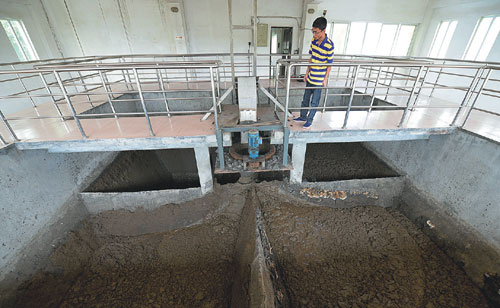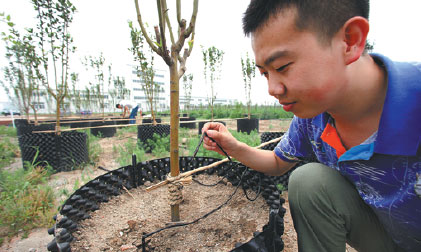Throwing money down the drain?
Updated: 2015-12-10 07:59
By Zheng Jinran(China Daily)
|
||||||||
The country's waste-treatment plants produce thousands of metric tons of sewage sludge every day, but a lack of funding for advanced processing means illegal dumping is rife and poses a potential safety threat to farmland and water sources. Zheng Jinran reports.
Every day since early March, Ma Xiaoxian, head of the Environmental Protection Enforcement Bureau in Shaanxi province, has been following trucks carrying sewage sludge in an attempt to find out where the waste is taken after processing. What he discovered left him deeply troubled.
Sewage sludge is residual, semi-solid material produced as a byproduct of the treatment of industrial or municipal wastewater.
In Xi'an, the capital of the northwestern province, around 600 metric tons of sewage sludge simply disappears every day, and Ma suspects that contractors are disposing of the pungent waste randomly, by dumping it on the side of the road, in villages and even on farmland.
In January 2009, the US Environmental Protection Agency's National Targeted Sewage Sludge Survey found that sewage sludge usually contains high concentrations of toxic elements, such as heavy metals from the atmosphere and water, steroids excreted by humans and "factory" animals, worm eggs and other substances that remain after treatment.
"If we are unable to control the disposal of sewage sludge, all the time and effort expended in processing sewage will be in vain, because it will not protect the environment," Ma said. "The rain can easily wash hazardous materials from the sludge, and that material then leaches into the soil and contaminates the environment."
The threat of pollution from sewage sludge is a problem facing Beijing as well, according to the Ministry of Environmental Protection. In August, the ministry said treatment plants operated by the Beijing Drainage Group, the capital's biggest provider of sewage-processing services, were only able to process about 10 percent of the 2,800 metric tons of sewage sludge produced every day.
The remaining 90 percent is either partially dried or piled in the open in the company's yards, emitting a fetid odor and posing a contamination risk for underground water sources.
According to Chen Zhenggao, minister of housing and urban-rural development, only about 50 percent of the sewage sludge produced every day in China is dealt with correctly, by being dried or burned as fuel. As only 33 percent is stored at temporary sites before further processing, the remaining 17 percent is subject to random disposal, and there are no records of its whereabouts, Chen said.
Sewage processing plants in urban areas generate 76,000 tons of sludge every day, Chen told national legislators at a meeting about water pollution controls on Aug 29. As a result, sewage sludge now poses a growing threat to China's water security.
A 'misplaced resource'
Sewage sludge is often called a "misplaced resource", because when treated correctly and rendered completely harmless, it can be utilized as a fuel, compost or fertilizer. That isn't happening, though, according to Cao Yanjin, a researcher with the Sewage and Sludge Management Bureau at the Ministry of Housing and Urban-Rural Development.
In the 12th Five-Year Plan (2011-15) on sewage and sludge management, released in 2010, the State Council listed a number of ways of making sludge environmentally harmless.
Of the three leading processes, the most-effective and most-recommended method is to remove the toxic contaminants and make the sludge suitable for use as soil in public gardens and parks.
The two other major solutions involve drying the sludge by adding coal dust and then using it as fuel, or employing a simple dehydration process to reduce the water content by about 80 percent and then burying the material in landfills.
"No matter whether it's used as recycled soil for public gardens or burned in plants, sewage sludge could be utilized more effectively, and that would reduce pollution greatly," Cao said, adding that the utilization rate of sewage sludge as a resource is disappointing low.
This year, a survey by the Ministry of Housing and Urban-Rural Development found that 56 percent of the country's sewage sludge is treated to eradicate toxic elements, and make it suitable for use as fuel or compost, or for burial.
The same figure was quoted by Chen, the minister, but a market analysis report by E20 Policy and Market Research, a think tank focused on domestic sludge, said the percentage had been overestimated. According to E20's annual report for 2014, only 10 percent of the sewage sludge was composted for use in public gardens.
The current treatment rate is far too low to allow local governments to achieve the targets set by the State Council in the 12th Five-Year Plan, which aimed for the proportion of sludge rendered harmless in major cities to rise to 70 percent by the end of the year, from 25 percent in 2010.
Cao said more than half of China's provinces have slow, unwieldy treatment processes, which makes it impossible for them to reach the targets.
Low treatment levels
The low level of treatment is the result of many factors, including a shortage of funds, lax management by the authorities, poor awareness of the pollution threat, and a lack of treatment standards. Added to that, the market to support the utilization of sludge is immature, according to local governments and research groups.
At a summit in July, Chen Cheng, a researcher at the National Development and Reform Commission's environment bureau, introduced an interim report on investment in sludge-processing systems.
He noted that the country planned to invest 34.7 billion yuan ($5.4 billion) between 2010 and the end of the 12th Five-Year Plan. However, by 2013, only 8 billion yuan had been invested in the construction of sludge-treatment facilities, accounting for less than 25 percent of the planned investment, far too little to finance any positive development.
Poor returns
"Sludge-treatment fees are included in the sewage charges paid by residents and companies," said Ren Yong, deputy head of the housing and urban-rural development bureau in Shaanxi province.
Although it costs 1 yuan to process every ton of sewage, only 0.2 yuan, or 20 percent, of that is spent on the treatment of sewage sludge, which is not enough to support the processing plants. That lays the financial burden of operating sewage-processing plants at the doors of cash-strapped local governments, who may be reluctant to foot the bill.
In addition, although the investment targets for sewage-processing facilities have been met, investment in sewage-sludge treatment lags far behind, indicating the governments' lack of awareness of sludge management, Cao said.
Many governments fail to understand the importance of the correct treatment of sludge because they are unaware of the potential environmental threat, she said, adding that the market is too immature to facilitate the use of sludge in environmentally beneficial ways.
After complex processing, sewage sludge can be made into compost suitable for use in public gardens, but there are no direct or smooth sales channels. Moreover, storage costs are prohibitively high, so few companies are willing to process the waste.
"Although processing sludge to make it into a resource is a good way of dealing with it, no company will do it if they can't see any benefits," said Yang Xinhai, chief engineer at the Shanghai Environmental Sanitation Engineering Design Institute.
Shanghai has used compost made from processed sewage sludge in its public gardens, but the rank smell prompted complaints from residents, he said. Also, the potential pollution risks posed by the compost mean many garden management authorities are reluctant to use it.
"The cost of turning sludge into compost is around 250 yuan per ton, and if the company cannot sell it, it costs a lot to store, lowering the profit greatly," Yang said.
Chen, the minister of housing, accepted that the treatment of sewage sludge is problematic, but pledged that the ministry will help local governments to tackle the problem and ensure that by 2020, 90 percent of the nation's annual generation of sewage sludge will be rendered harmless.
Contact the writer at zhengjinran@chinadaily.com.cn
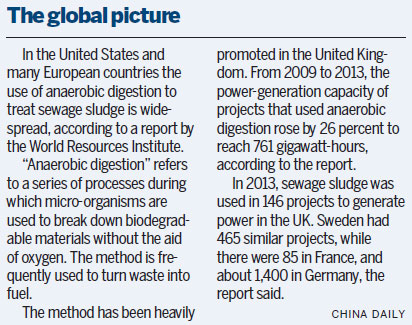
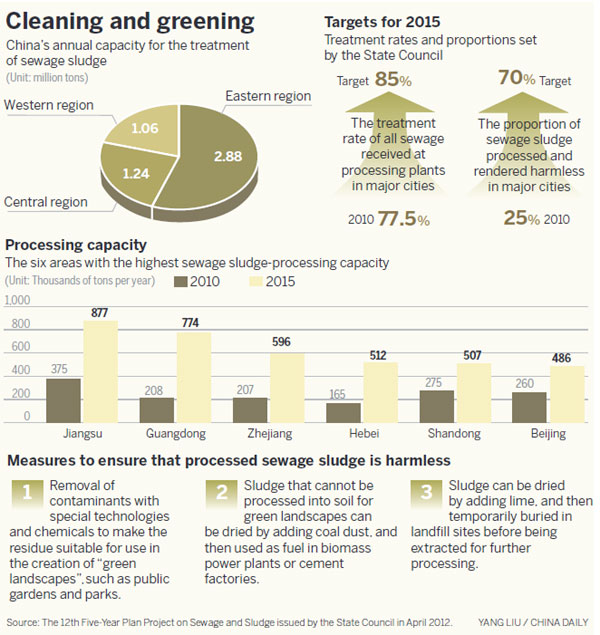
|
Sludge in a storage facility at a sewage plant in Liuzhou in the Guangxi Zhuang autonomous region. Li Hanchi / Xinhua |
|
Plants being cultivated in soil developed from sludge at a company in Tianjin, North China. Zhen Zishan / Xinhua |
(China Daily 12/10/2015 page6)
- People exit rebel-held area in Syrian peace deal
- Two DPRK music groups to perform in China
- False bomb alert prompts security measures at Mexico City airport
- Russia fires missiles at IS positions
- US House passes bill to tighten visa waiver program
- Obama, Modi vow to secure 'strong' climate change agreement

 Panchen Lama enthronement 20th anniversary celebrated
Panchen Lama enthronement 20th anniversary celebrated
 Printer changes the chocolates into the 3rd dimension
Printer changes the chocolates into the 3rd dimension
 Think all Chinese dama do is dance, buy gold? Think again
Think all Chinese dama do is dance, buy gold? Think again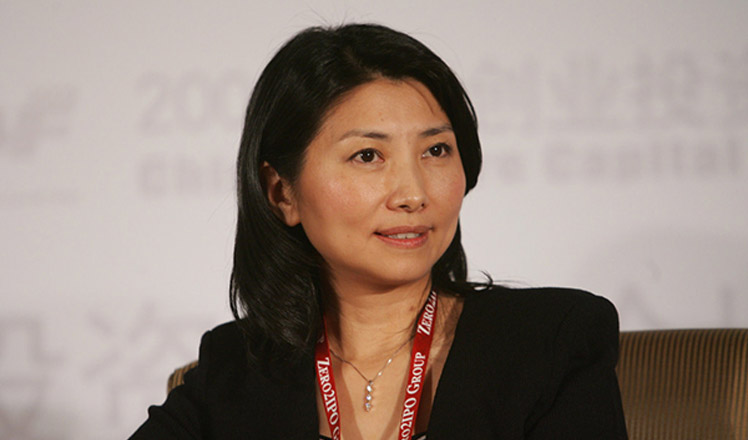
 China's top 10 venture capital firms
China's top 10 venture capital firms
 33-car pileup leaves six dead, four injured in Shanxi
33-car pileup leaves six dead, four injured in Shanxi
 US marks 74th anniversary of Pearl Harbor attacks
US marks 74th anniversary of Pearl Harbor attacks
 Christmas lights across the world's shopping districts
Christmas lights across the world's shopping districts
 Top 10 best airports where flight delays aren't a pain
Top 10 best airports where flight delays aren't a pain
Most Viewed
Editor's Picks

|

|

|

|

|

|
Today's Top News
Shooting rampage at US social services agency leaves 14 dead
Chinese bargain hunters are changing the retail game
Chinese president arrives in Turkey for G20 summit
Islamic State claims responsibility for Paris attacks
Obama, Netanyahu at White House seek to mend US-Israel ties
China, not Canada, is top US trade partner
Tu first Chinese to win Nobel Prize in Medicine
Huntsman says Sino-US relationship needs common goals
US Weekly

|

|
